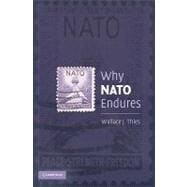
Note: Supplemental materials are not guaranteed with Rental or Used book purchases.
Purchase Benefits
Looking to rent a book? Rent Why NATO Endures [ISBN: 9780521749794] for the semester, quarter, and short term or search our site for other textbooks by Wallace J. Thies. Renting a textbook can save you up to 90% from the cost of buying.
| Preface | p. ix |
| The Curious Relationship | p. 1 |
| The Alliance Crisis Syndrome | p. 2 |
| Exaggerated Claims | p. 3 |
| Unexamined Premises | p. 7 |
| Superficial Comparisons | p. 9 |
| A Crisis in the Alliance: Concept Clarification | p. 14 |
| A Crisis in the Alliance: Concept Development | p. 18 |
| Getting Out of a Blind Alley | p. 20 |
| Rivalry and Community in Interstate Alliances Prior to the Second World War | p. 25 |
| Alliances in Eighteenth-Century Europe | p. 27 |
| The French Revolution and the Napoleonic Wars | p. 39 |
| European Alliances, 1822-1854 | p. 52 |
| Alliances during the Second Half of the Nineteenth Century | p. 57 |
| The First World War | p. 71 |
| Alliances during the Interwar Period | p. 82 |
| Creating a Contentious Alliance | p. 87 |
| American Views on the Need for an Alliance | p. 90 |
| Military Arrangements | p. 99 |
| The Impact of the Korean War | p. 106 |
| Putting the "Collective" in Collective Defense | p. 113 |
| A Contentious Alliance | p. 116 |
| Why NATO Is Different | p. 120 |
| The Transformation of Alliance Relationships | p. 120 |
| Why NATO Is Different (I): The Political Consequences of Military Integration | p. 127 |
| Why NATO Is Different (II): The Choices Allies Face | p. 130 |
| Why NATO Is Different (III): Interests and Outcomes | p. 134 |
| Why These Differences Matter | p. 139 |
| NATO and the Military Balance | p. 140 |
| NATO during the 1950s: The Crisis over Soviet Ballistic Missiles | p. 142 |
| Background | p. 142 |
| Why the Missiles Issue was Thought to be a NATO Crisis | p. 148 |
| What Actually Happened? | p. 149 |
| The Strategic Balance and Extended Deterrence | p. 150 |
| The Conventional Imbalance | p. 157 |
| The Suicide/Surrender Dilemma | p. 163 |
| Conclusion | p. 173 |
| The INF Crisis | p. 175 |
| Background | p. 175 |
| Why the INF Case was Thought to be a NATO Crisis | p. 182 |
| What Actually Happened? | p. 185 |
| NATO Missiles and European Attitudes | p. 186 |
| Did Any NATO Member Cross the Crisis Threshold? | p. 190 |
| Resisting Soviet Coercion | p. 197 |
| Conclusion | p. 199 |
| NATO and the Out-of-Area Issue | p. 202 |
| The 1956 Suez Crisis | p. 203 |
| Background | p. 203 |
| Why Suez was Thought to be a NATO Crisis | p. 205 |
| What Actually Happened? | p. 207 |
| Conclusion | p. 218 |
| The Soviet Invasion of Afghanistan | p. 222 |
| Background | p. 222 |
| Why the Soviet Invasion of Afghanistan was Thought to be a NATO Crisis | p. 226 |
| What Actually Happened? | p. 230 |
| The Afghanistan Case in Retrospect | p. 239 |
| Conclusion | p. 240 |
| Nonmilitary Issues | p. 242 |
| The Soviet Pipeline Crisis | p. 243 |
| Background | p. 243 |
| Why the Pipeline Issue was Thought to be NATO's Worst Crisis Ever | p. 253 |
| What Actually Happened? | p. 257 |
| Conclusion | p. 272 |
| The Bosnian Civil War | p. 273 |
| Background | p. 273 |
| Why Bosnia was Thought to be NATO's Worst Crisis Ever | p. 276 |
| What Actually Happened? | p. 279 |
| Conclusion | p. 284 |
| Why NATO Endures | p. 287 |
| Why NATO Is Different | p. 287 |
| Why NATO Endures | p. 294 |
| The Iraq Crisis Revisited | p. 302 |
| A Final Word | p. 306 |
| Index | p. 309 |
| Table of Contents provided by Ingram. All Rights Reserved. |
The New copy of this book will include any supplemental materials advertised. Please check the title of the book to determine if it should include any access cards, study guides, lab manuals, CDs, etc.
The Used, Rental and eBook copies of this book are not guaranteed to include any supplemental materials. Typically, only the book itself is included. This is true even if the title states it includes any access cards, study guides, lab manuals, CDs, etc.